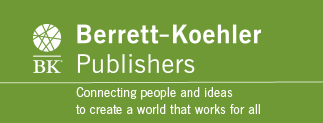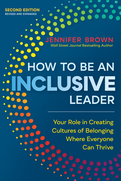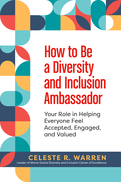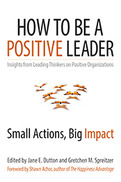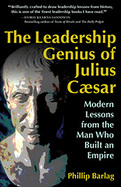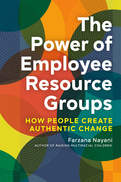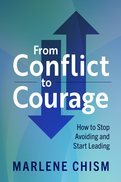Search Results: "how to be an inclusive leader"
Results 1-6 of 663
This compelling and inspiring call to action for leaders at every level helps them find their role and voice in affecting societal and workplace change.
The need for inclusive leadership has never been more urgent. In the United States, the wealth gap is the greatest it has ever been, with women, people of color, and other marginalized communities being the most impacted by economic and societal inequities. In the workplace, representation is still sorely lacking across every industry. Pay disparities, low wages, and lack of benefits continue to characterize many jobs in the nation's labor force. These realities have an impact on generations, communities, and our society overall. To build a more equitable future, leaders must grasp the urgency of their role and responsibility in the change effort.
In this updated and greatly expanded second edition of her bestselling book, Jennifer Brown takes a deeper dive into what it takes to be an inclusive leader and examines the challenges and mindsets that continue to hold many leaders back. Combining nearly two decades of professional DEI expertise with personal experience and reflection, she tackles complex topics such as identity, privilege, and systemic inequities. Following her widely acclaimed Inclusive Leader Continuum, Brown makes the journey to becoming an inclusive leader more informed and actionable by offering new structure and content throughout the new edition of the book, including new insights and stories, detailed strategies and tools, and discussion guides to spark learning at the individual and organizational levels.
Whether you are already a fan of the first edition of How to Be an Inclusive Leader or are just embarking on your journey to become a more inclusive leader, this book will meet you where you are and equip you to take action and step into your role in the change effort.
The need for inclusive leadership has never been more urgent. In the United States, the wealth gap is the greatest it has ever been, with women, people of color, and other marginalized communities being the most impacted by economic and societal inequities. In the workplace, representation is still sorely lacking across every industry. Pay disparities, low wages, and lack of benefits continue to characterize many jobs in the nation's labor force. These realities have an impact on generations, communities, and our society overall. To build a more equitable future, leaders must grasp the urgency of their role and responsibility in the change effort.
In this updated and greatly expanded second edition of her bestselling book, Jennifer Brown takes a deeper dive into what it takes to be an inclusive leader and examines the challenges and mindsets that continue to hold many leaders back. Combining nearly two decades of professional DEI expertise with personal experience and reflection, she tackles complex topics such as identity, privilege, and systemic inequities. Following her widely acclaimed Inclusive Leader Continuum, Brown makes the journey to becoming an inclusive leader more informed and actionable by offering new structure and content throughout the new edition of the book, including new insights and stories, detailed strategies and tools, and discussion guides to spark learning at the individual and organizational levels.
Whether you are already a fan of the first edition of How to Be an Inclusive Leader or are just embarking on your journey to become a more inclusive leader, this book will meet you where you are and equip you to take action and step into your role in the change effort.
Using a proven three-part framework, this book shows how anyone-from a CEO to frontline employee-can play a pivotal role in creating a diverse and welcoming workplace.
Creating a diverse workplace needs to be an ongoing effort, not just the subject of occasional training. As Celeste Warren says, needed change won't take place unless all employees feel that they have a role to play in creating the culture they would like to see in their organization.
Regardless of what position you hold, you have the ability to impact change and create a more inclusive environment. Anyone can commit to becoming an unofficial Diversity and Inclusion Ambassador in his or her organization. Warren offers a straightforward three-stage model:
Become aware of your strengths, weaknesses, and conscious and unconscious biases.
Take an inventory of your surroundings: what is getting in the way of there being an inclusive environment in your organization?
Develop a personal action plan.
Depending on your position, the actions you take can be as simple as consistently raising DEI-related issues in staff meetings or as far-reaching as leading an Employee Resource Group or developing a new hiring policy. In separate chapters, Warren offers specific advice for chief diversity and inclusion officers, C-suite leaders, first-line managers, human resources practitioners, and individual contributors. This book features examples, exercises, and practical tools that show you how to assess where your organization is at and develop a purpose and strategy that can make diversity a workplace reality.
Creating a diverse workplace needs to be an ongoing effort, not just the subject of occasional training. As Celeste Warren says, needed change won't take place unless all employees feel that they have a role to play in creating the culture they would like to see in their organization.
Regardless of what position you hold, you have the ability to impact change and create a more inclusive environment. Anyone can commit to becoming an unofficial Diversity and Inclusion Ambassador in his or her organization. Warren offers a straightforward three-stage model:
Become aware of your strengths, weaknesses, and conscious and unconscious biases.
Take an inventory of your surroundings: what is getting in the way of there being an inclusive environment in your organization?
Develop a personal action plan.
Depending on your position, the actions you take can be as simple as consistently raising DEI-related issues in staff meetings or as far-reaching as leading an Employee Resource Group or developing a new hiring policy. In separate chapters, Warren offers specific advice for chief diversity and inclusion officers, C-suite leaders, first-line managers, human resources practitioners, and individual contributors. This book features examples, exercises, and practical tools that show you how to assess where your organization is at and develop a purpose and strategy that can make diversity a workplace reality.
Positive leaders are able to dramatically expand their people's—and their own—capacity for excellence. And they accomplish this without enormous expenditures or huge heroic gestures. Here leading scholars—including Adam Grant, author of the bestselling Give and Take; positive organizational scholarship movement cofounders Kim Cameron and Robert Quinn; and thirteen more—describe how this is being done at companies such as Wells Fargo, Ford, Kelly Services, Burt's Bees, Connecticut's Griffin Hospital, the Michigan-based Zingerman's Community of Businesses, and many others. They show that, like the butterfly in Brazil whose flapping wings create a typhoon in Texas, you can create profound positive change in your organization through simple actions and attitude shifts.
The Leadership Genius of Julius Caesar
Modern Lessons from the Man Who Built an Empire
“Brilliantly crafted to draw leadership lessons from history, this is one of the finest leadership books I have read.”
—Doris Kearns Goodwin, bestselling author of Team of Rivals and The Bully Pulpit
Leaders are always trying to get better, which is why there is an enormous and growing collection of literature offering the latest leadership paradigm or process. But sometimes the best way to move forward is to look back. Philip Barlag shows us that Julius Caesar is one of the most compelling leaders of the past to study—a man whose approach was surprisingly modern and extraordinarily effective.
History is littered with leaders hopelessly out of touch with their people and ruthlessly pursuing their own ambitions or hedonistic whims. But Caesar, who rose from impoverished beginnings, proved by his words and deeds that he never saw himself as being above the average Roman citizen. And he had an amazing ability to generate loyalty, to turn enemies into allies and allies into devoted followers.
Barlag uses dramatic and colorful incidents from Caesar's career—being held hostage by pirates, charging headlong alone into enemy lines, pardoning people he knew wanted him dead—to illustrate what Caesar can teach leaders today. Central to Barlag's argument is the distinction between force and power. Caesar avoided using brute force on his followers, understanding that fear never generates genuine loyalty. He exercised a power deeply rooted in his demonstrated personal integrity and his intuitive understanding of people's deepest needs and motivations. His supporters followed him because they wanted to, not because they were compelled to. Over 2,000 years after Caesar's death, this is still the kind of loyalty every leader wants to inspire. Barlag shows how anyone can learn to lead like Caesar.
Modern Lessons from the Man Who Built an Empire
“Brilliantly crafted to draw leadership lessons from history, this is one of the finest leadership books I have read.”
—Doris Kearns Goodwin, bestselling author of Team of Rivals and The Bully Pulpit
Leaders are always trying to get better, which is why there is an enormous and growing collection of literature offering the latest leadership paradigm or process. But sometimes the best way to move forward is to look back. Philip Barlag shows us that Julius Caesar is one of the most compelling leaders of the past to study—a man whose approach was surprisingly modern and extraordinarily effective.
History is littered with leaders hopelessly out of touch with their people and ruthlessly pursuing their own ambitions or hedonistic whims. But Caesar, who rose from impoverished beginnings, proved by his words and deeds that he never saw himself as being above the average Roman citizen. And he had an amazing ability to generate loyalty, to turn enemies into allies and allies into devoted followers.
Barlag uses dramatic and colorful incidents from Caesar's career—being held hostage by pirates, charging headlong alone into enemy lines, pardoning people he knew wanted him dead—to illustrate what Caesar can teach leaders today. Central to Barlag's argument is the distinction between force and power. Caesar avoided using brute force on his followers, understanding that fear never generates genuine loyalty. He exercised a power deeply rooted in his demonstrated personal integrity and his intuitive understanding of people's deepest needs and motivations. His supporters followed him because they wanted to, not because they were compelled to. Over 2,000 years after Caesar's death, this is still the kind of loyalty every leader wants to inspire. Barlag shows how anyone can learn to lead like Caesar.
This is the first authoritative book on building employee resource groups (ERGs) to empower underrepresented employees and positively impact diversity, equity, and inclusion (DEI) efforts within organizations and in society at large.
In existence for decades, ERGs originated out of affirmative action policies and have evolved into powerful sources of employee activity and engagement. Organizations can leverage ERGs to support business goals, but ERGs can also play a critical role in creating a more inclusive work environment for marginalized individuals. ERGs represent a balance of serving company interests and empowering employees, offering the opportunity for innovative leadership within organizations. This book is a practical guide on how to manage ERGs effectively and how they inspire a deeper connection between employees and companies while helping us progress toward the DEI goals that we aim to accomplish. Participating in an ERG can help professionals of color and other historically excluded groups advance their careers, thereby increasing diverse representation in leadership. Farzana Nayani provides foundational tools for starting ERGs and outlines the five Ps-purpose, people, processes, planning, and priorities-needed to successfully operate them. Unlike other ERG handbooks, this book is people-centric and socially conscious and thoughtfully takes into account the experiences of employees and leaders during current times. It also serves as a deeper call to action around how ERGs can foster authentic change within organizations, creating transformative impact in the surrounding world.
In existence for decades, ERGs originated out of affirmative action policies and have evolved into powerful sources of employee activity and engagement. Organizations can leverage ERGs to support business goals, but ERGs can also play a critical role in creating a more inclusive work environment for marginalized individuals. ERGs represent a balance of serving company interests and empowering employees, offering the opportunity for innovative leadership within organizations. This book is a practical guide on how to manage ERGs effectively and how they inspire a deeper connection between employees and companies while helping us progress toward the DEI goals that we aim to accomplish. Participating in an ERG can help professionals of color and other historically excluded groups advance their careers, thereby increasing diverse representation in leadership. Farzana Nayani provides foundational tools for starting ERGs and outlines the five Ps-purpose, people, processes, planning, and priorities-needed to successfully operate them. Unlike other ERG handbooks, this book is people-centric and socially conscious and thoughtfully takes into account the experiences of employees and leaders during current times. It also serves as a deeper call to action around how ERGs can foster authentic change within organizations, creating transformative impact in the surrounding world.
Unresolved conflict is workplace kryptonite. Learn how to develop the mindset and skills to defuse disagreements, overcome division, and turn conflict into an opportunity for growth.
Unresolved workplace conflict wastes time, increases stress, and negatively affects business outcomes. But conflict isn't the problem, mismanagement is.
Leaders unintentionally mismanage conflict when they fall into patterns of what Marlene Chism calls “the Three As:” aggression, avoidance, and appeasing. “These coping mechanisms are ways human beings avoid the emotions that come with conflict, but in the end it's all avoidance,” says Chism. In this book she shows how to fearlessly deal with conflict head-on by expanding your conflict capacity.
Conflict capacity is a combination of three elements. The foundation is the Inner Game—the leader's self-awareness, values, discernment, and emotional integrity. The Outer Game is the skills, tools, and communication techniques built on that foundation. Finally, there's Culture—the visible and invisible structures around you that can encourage or discourage conflict.
Chism offers exercises, examples, and expert guidance on developing all three elements. Leaders will discover techniques to increase leadership clarity, identify obstacles, and reduce resistance. They'll develop powerful skills for dealing with high-conflict people and for initiating, engaging in, and staying with difficult conversations.
Readers will learn that when they see conflict as a teacher, courageously face it, and continually work on transforming themselves, they can get the resolution they are seeking. They can change minds.
Unresolved workplace conflict wastes time, increases stress, and negatively affects business outcomes. But conflict isn't the problem, mismanagement is.
Leaders unintentionally mismanage conflict when they fall into patterns of what Marlene Chism calls “the Three As:” aggression, avoidance, and appeasing. “These coping mechanisms are ways human beings avoid the emotions that come with conflict, but in the end it's all avoidance,” says Chism. In this book she shows how to fearlessly deal with conflict head-on by expanding your conflict capacity.
Conflict capacity is a combination of three elements. The foundation is the Inner Game—the leader's self-awareness, values, discernment, and emotional integrity. The Outer Game is the skills, tools, and communication techniques built on that foundation. Finally, there's Culture—the visible and invisible structures around you that can encourage or discourage conflict.
Chism offers exercises, examples, and expert guidance on developing all three elements. Leaders will discover techniques to increase leadership clarity, identify obstacles, and reduce resistance. They'll develop powerful skills for dealing with high-conflict people and for initiating, engaging in, and staying with difficult conversations.
Readers will learn that when they see conflict as a teacher, courageously face it, and continually work on transforming themselves, they can get the resolution they are seeking. They can change minds.
